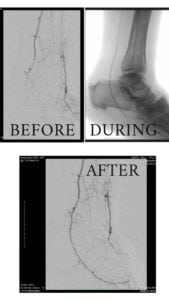Worried about leg pain PAD? You're not alone! Peripheral Arterial Disease is a tricky condition. Its symptoms look like many other vein health problems. Meaning you often wait to get your diagnosis. Take a classic symptom like tired, heavy legs, for example. At some point, everyone’s legs get tired. If you’ve walked a lot during the day, had a hard work out, or just been stuck on your feet, you may get muscle cramps or leg fatigue. And that would be perfectly normal. Sometimes, however, that discomfort in your legs could be something more serious: peripheral arterial disease, a condition in which plaque narrows your arteries, limiting blood flow to your lower extremities. Here’s how you can tell when your leg pain is a cause for concern. And a roundup of other warning signs and symptoms that could indicate trouble with your blood flow.

PAD-affected arteries before, during and after minimally invasive treatments
The above symptoms aren't all you need to watch out for. Other signs of PAD include cold, numb legs and feet; changes in your skin color; poor toenail growth; changes in your leg-hair growth; and even erectile dysfunction in men.
We can diagnose PAD in our office with a bedside test called an Ankle-Brachial Index (ABI), which uses ultrasound and blood pressure cuffs to evaluate the circulation in your arms and legs. If this test is abnormal we may order further imaging tests such as Magnetic Resonance Angiography (MRA) or Computed Tomography (CT) to determine the extent of your problem and help us plan your treatment.
PAD is a serious medical condition, but help is readily available, often without surgery. Using minimally invasive procedures, our Houston and Dallas area vein specialists can help open up your arteries and restore blood flow to your lower extremities. But before we can help, you need an accurate diagnosis, so watch for warning signs and see your doctor right away if you have any cause for concern.

Scheduling
Please contact our dedicated specialists to schedule a consultation today.
2024 Texas Endovascular. All rights reserved. Website Design by Healthcare Success